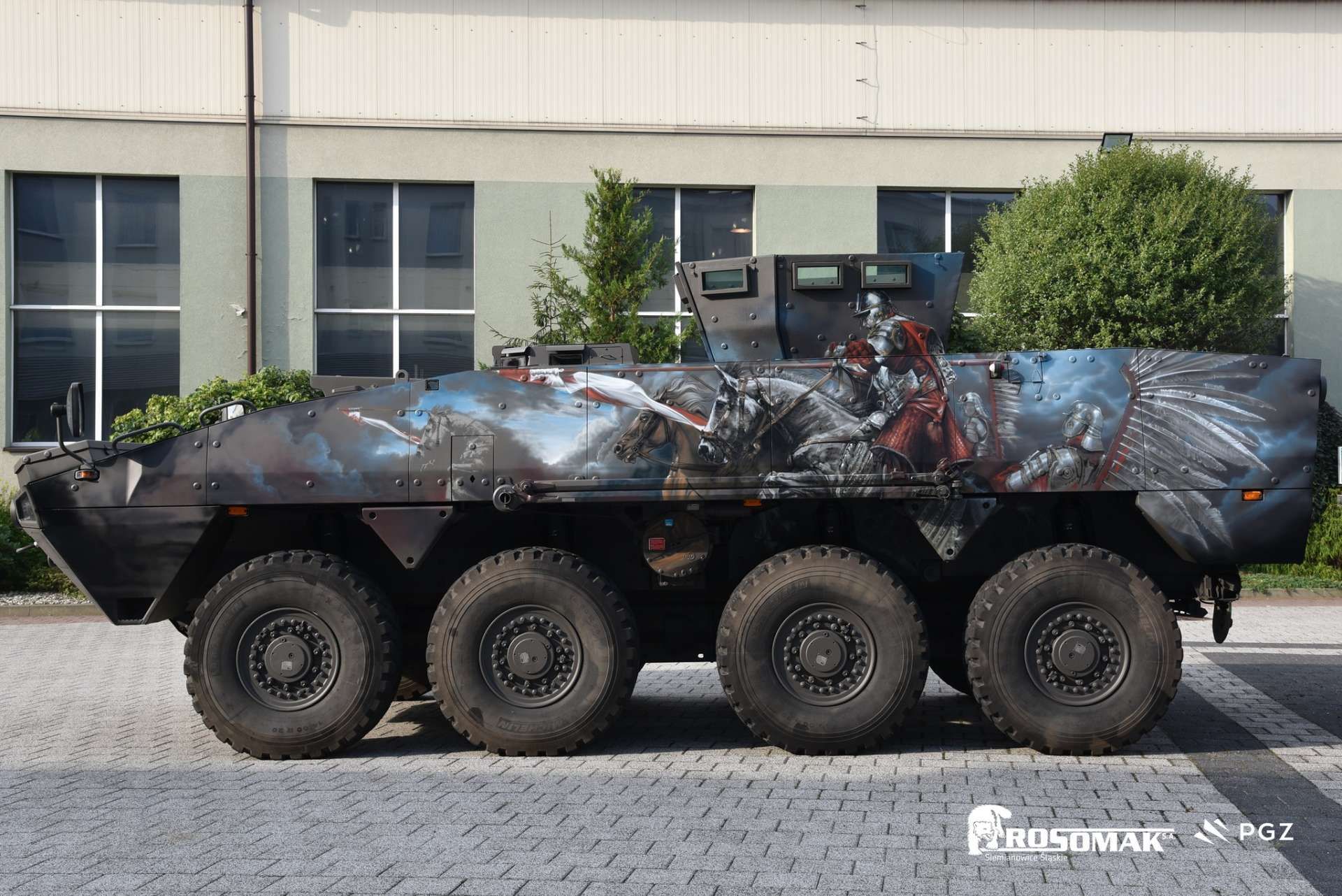Breaking News
Polish Army to redefine command capabilities with new Rosomak Kroton.
At the MSPO 2024 defense exhibition, the Polish Armed Forces introduced the Rosomak Kroton, a new command vehicle designed to support communication, decision-making, and command functions in military operations. The vehicle is based on the Rosomak armored personnel carrier (APC) and features a teleinformation and internal communication system designed to enhance information flow and decision-making in military command environments.
Follow Army Recognition on Google News at this link

The Rosomak Kroton features a communication, command, and control system, as well as field antennas, and a 15-meter semi-automatic folding mast to extend the communication range of VHF radio stations. (Picture source: Army Recognition)
Designed to accommodate an operational crew of four and equipped with various communication systems, the Rosomak Kroton is configured to function as a mobile command post, capable of maintaining communication with commanders, subordinate units, and allied forces both while on the move and when stationary. The communication suite of the Rosomak Kroton includes an AN/PRC-150C Falcon II Manpack HF radio and three 117G Multiband Networking Manpack Radios, which operate on UHF and VHF frequencies. Additionally, the vehicle is equipped with an RRC 9311AP F@stnet PR4G on-board tactical UHF radio, providing multiple options for maintaining connectivity in different operational scenarios.
The Rosomak Kroton has a crew capacity of three, with four operational workstations. It measures 8,425 mm in length, 2,855 mm in width, and 3,310 mm in height, and can reach a maximum speed of 100 km/h on various terrain types. It is equipped with several systems to enhance its operational capabilities, including the SSP1 G "OBRA-3" vehicle self-protection system, which incorporates 81 mm smoke grenade launchers. The vehicle also features a communication, command, and control system, as well as navigation and positioning systems utilizing the DAGR GPS device, field antennas, and a 15-meter semi-automatic folding mast to extend the communication range of VHF radio stations. Additionally, the Rosomak Kroton includes a fire and explosion protection system and an ABC filtering system, providing protection against nuclear, biological, and chemical threats.
Poland's acquisition of the KTO Rosomak began with a contract for 690 vehicles, which was later expanded to 997 units by 2019. The vehicles were manufactured domestically by Rosomak S.A., a subsidiary of the Polish Armaments Group, located in Siemianowice Śląskie. The procurement process included different variants, such as combat APCs with Hitfist-30P turrets, command vehicles, medical evacuation vehicles, and reconnaissance vehicles, along with provisions for technology transfer and local production to strengthen Poland's defense capabilities.

The primary version of the Rosomak is equipped with a Hitfist-30P turret that includes a 30mm cannon and a coaxial 7.62 mm machine gun, but the Rosomak-M2 and M3 are patrol variants armed with lighter weapons such as a 12.7 mm machine gun. (Picture source: Rosomak SA)
The KTO Rosomak, also known as "Wolverine" in Polish, is an 8×8 wheeled armored personnel carrier (APC) developed under license from the Finnish Patria AMV. In 2002, the Polish Ministry of National Defense selected the Patria AMV following a competitive evaluation that included other options such as the MOWAG Piranha and Steyr Pandur. The initial contract was for 690 vehicles to be produced in Poland, intended to replace the aging OT-64 SKOT and BMP-1 APCs in the Polish Land Forces. This order was later expanded, and in July 2023, Poland began supplying 200 Rosomak Infantry Fighting Vehicles (IFVs) to Ukraine, a delivery funded by the European Union and the United States.
The KTO Rosomak has a monocoque hull made from welded armored steel, which provides baseline protection against small arms and artillery fragments, with the capability to add ceramic or composite armor to increase resistance to ballistic threats. The standard protection meets NATO STANAG 4569 standards, offering defense against 14.5 mm rounds at the front and 7.62 mm rounds from other directions. For operations in conflict zones like Afghanistan, some Rosomaks were equipped with additional armor and anti-RPG mesh screens to enhance their defense against shaped-charge weapons and improvised explosive devices (IEDs). The vehicle also has an anti-splinter lining to reduce the effects of internal explosions.
The primary combat version of the Rosomak is equipped with a Hitfist-30P turret that includes a 30mm cannon, a 7.62 mm machine gun, and can be fitted with anti-tank guided missiles. The Rosomak-M2 and M3 are patrol variants with turntables for lighter weapons such as machine guns or grenade launchers, configured for specific operational environments like Afghanistan and Chad. Other variants are designed for specialized roles, such as the Rosomak-WEM for medical evacuation, which features an extended interior for stretchers and medical equipment, and the Rosomak-S, configured to transport Spike anti-tank guided missiles. Additional versions include command vehicles, reconnaissance vehicles equipped with advanced surveillance technology, and the M120K Rak, a self-propelled mortar mounted on the Rosomak chassis.


























